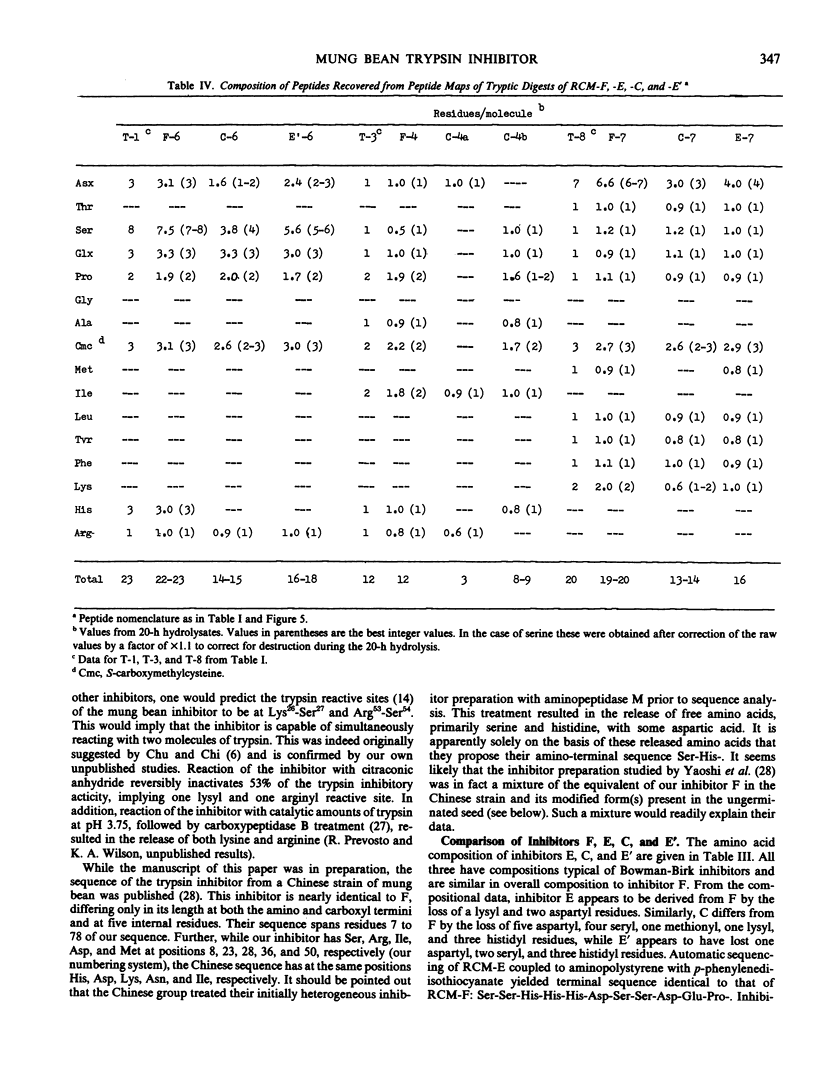Abstract
The amino acid sequence of the major trypsin inhibitor, F, of ungerminated mung beans (Vigna radiata [L.] Wilczek) was determined by a combination of automatic solid phase and manual sequencing techniques. F is a typical Bowman-Birk-type proteinase inhibitor with 80 amino acid residues and exhibits a high degree of identity with the other sequenced members of the Bowman-Birk family of inhibitors. Thin layer peptide maps of mung bean inhibitors E and C (which appear during germination) indicate that both are derived from inhibitor F by limited specific proteolysis. Loss of the carboxyl-terminal residues 77 to 80 from F produces inhibitor E, while the loss of an additional two carboxyl-terminal residues, the loss of the amino-terminal residues 1 to 8, and an internal cleavage at Ala35-Asp36 produces inhibitor C from E. Another inhibitor species, E′, was isolated from ungerminated seeds. It differs from F in the loss of residues 1 to 6. The majority of the proteolytic cleavages noted in the F-E-C-E′ system are at peptide bonds involving aspartyl residues.
Full text
PDF








Images in this article
Selected References
These references are in PubMed. This may not be the complete list of references from this article.
- Baumgartner B., Chrispeels M. J. Partial characterization of a protease inhibitor which inhibits the major endopeptidase present in the cotyledons of mung beans. Plant Physiol. 1976 Jul;58(1):1–6. doi: 10.1104/pp.58.1.1. [DOI] [PMC free article] [PubMed] [Google Scholar]
- Baumgartner B., Chrispeels M. J. Purification and characterization of vicilin peptidohydrolase, the major endopeptidase in the cotyledons of mung-bean seedlings. Eur J Biochem. 1977 Jul 15;77(2):223–233. doi: 10.1111/j.1432-1033.1977.tb11661.x. [DOI] [PubMed] [Google Scholar]
- Chrispeels M. J., Boulter D. Control of storage protein metabolism in the cotyledons of germinating mung beans: role of endopeptidase. Plant Physiol. 1975 Jun;55(6):1031–1037. doi: 10.1104/pp.55.6.1031. [DOI] [PMC free article] [PubMed] [Google Scholar]
- Chü H. M., Chi C. W. The isolation and crystallization of two trypsin inhibitors of low molecular weight from mung bean (Phaseolus aureus Roxb.). Sci Sin. 1965 Oct;14(10):1441–1453. [PubMed] [Google Scholar]
- DAVIS B. J. DISC ELECTROPHORESIS. II. METHOD AND APPLICATION TO HUMAN SERUM PROTEINS. Ann N Y Acad Sci. 1964 Dec 28;121:404–427. doi: 10.1111/j.1749-6632.1964.tb14213.x. [DOI] [PubMed] [Google Scholar]
- KOSTKA V., CARPENTER F. H. INHIBITION OF CHYMOTRYPSIN ACTIVITY IN CRYSTALLINE TRYPSIN PREPARATIONS. J Biol Chem. 1964 Jun;239:1799–1803. [PubMed] [Google Scholar]
- Kiyohara T., Yokota K., Masaki Y., Matsui O., Iwasaki T., Yoshikawa M. The amino acid sequences of proteinase inhibitors I-A and I-A' from adzuki beans. J Biochem. 1981 Sep;90(3):721–728. doi: 10.1093/oxfordjournals.jbchem.a133526. [DOI] [PubMed] [Google Scholar]
- Lai C. Y. Regeneration of amino acids from anilinothiazolinones. Methods Enzymol. 1977;47:369–373. doi: 10.1016/0076-6879(77)47038-1. [DOI] [PubMed] [Google Scholar]
- Lorensen E., Prevosto R., Wilson K. A. The Appearance of New Active Forms of Trypsin Inhibitor in Germinating Mung Bean (Vigna radiata) Seeds. Plant Physiol. 1981 Jul;68(1):88–92. doi: 10.1104/pp.68.1.88. [DOI] [PMC free article] [PubMed] [Google Scholar]
- Odani S., Ikenaka T. Studies on soybean trypsin inhibitors, XII. Linear sequences of two soybean double-headed trypsin inhibitors, D-II and E-I. J Biochem. 1978 Mar;83(3):737–745. doi: 10.1093/oxfordjournals.jbchem.a131967. [DOI] [PubMed] [Google Scholar]
- Odani S., Ikenaka T. Studies on soybean trypsin inhibitors. IV. Complete amino acid sequence and the anti-proteinase sites of Bowman-Birk soybean proteinase inhibitor. J Biochem. 1972 May;71(5):839–848. doi: 10.1093/oxfordjournals.jbchem.a129833. [DOI] [PubMed] [Google Scholar]
- Udenfriend S., Stein S., Böhlen P., Dairman W., Leimgruber W., Weigele M. Fluorescamine: a reagent for assay of amino acids, peptides, proteins, and primary amines in the picomole range. Science. 1972 Nov 24;178(4063):871–872. doi: 10.1126/science.178.4063.871. [DOI] [PubMed] [Google Scholar]
- Wachter E., Machleidt W., Hofner H., Otto J. Aminopropyl glass and its p-phenylene diisothiocyanate derivative, a new support in solid-phase Edman degradation of peptides and proteins. FEBS Lett. 1973 Sep 1;35(1):97–102. doi: 10.1016/0014-5793(73)80585-x. [DOI] [PubMed] [Google Scholar]
- Waxdal M. J., Konigsberg W. H., Henley W. L., Edelman G. M. The covalent structure of a human gamma G-immunoglobulin. II. Isolation and characterization of the cyanogen bromide fragments. Biochemistry. 1968 May;7(5):1959–1966. doi: 10.1021/bi00845a046. [DOI] [PubMed] [Google Scholar]
- Wilson K. A., Laskowski M., Sr The partial amino acid sequence of trypsin inhibitor II from garden bean, Phaseolus vulgaris, with location of the trypsin and elastase-reactive sites. J Biol Chem. 1975 Jun 10;250(11):4261–4267. [PubMed] [Google Scholar]
- Zhang Y., Luo S., Tan F., Qi Z., Xu L., Zhang A. Complete amino acid sequence of mung bean trypsin inhibitor. Sci Sin B. 1982 Mar;25(3):268–277. [PubMed] [Google Scholar]



